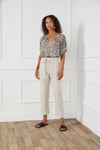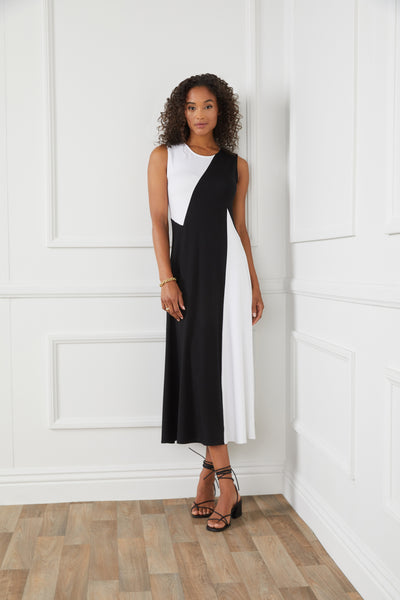
Springtime is alive with blooming tulips, warm breezes, and the very first sprouts of your summertime veggie garden. It also brings a potpourri of weather patterns—from sunny skies and rain showers to tornadoes and snow squalls.
How does a gal even get dressed—let alone transition her outfits from winter to spring—in that daily weather maelstrom?
Simply put, she layers. Beyond pairing scarves with sundresses and blazers with hoodies, we’ve got a few more style tricks up our sleeves. Tune into our expert guide to help you find your best best winter-to-spring transition outfits this season.
Create a Wardrobe Layer Cake
When days start off drizzly but end up balmy (or vice versa), you need to be able to add or remove layers easily from your outfit—without sacrificing style and composition. Depending on your local climate, you may need to take downpours, heat waves, or even blizzards into your springtime outfit consideration.
That said, layering sufficiently without looking bulky on an all-weather day can be a feat.
Breaking your outfit into two parts—top and bottom—and considering each part separately might help start the process of creating winter-spring outfit ideas.

Layer The Top
Perhaps your most obvious layering zone is from your neck to your waist. Having the ability to peel off and put on layers as needed will be key to keeping you cool and comfortable as the days grow longer.
Consider covering your top half as follows for a basic springtime look:
- Start with your favorite lacy (and supportive) bralette
- Cover with a camisole or crop top
- Add a long-sleeve thermal for a chilly day or a basic tee if the weather’s warm
- Top that with a cozy hoodie (either in a neutral tone or with eye-catching graphics)
- Finish it off with an oversized blazer
Whether you’re running errands or meeting up with friends for happy hour on the patio, this fit will give you plenty of ways to adjust to whatever springtime weather may come your way.
Layered Lines
A basic rule of clothing is that horizontal lines create width. Stripes and patterns have this effect, but so do hemlines. This means the bottom hemline of your top catches the eye and establishes that as the widest point. In this case, avoid wearing a top that ends at a point you’d prefer to minimize.
So, how does this affect your springtime top layering?
It means you need to incorporate both vertical lines and varying horizontal hemlines to give your top half some balance.
Here are a few tips to help you mind your shape and lines, keeping your upper body flattered instead of flattened:
- Add vertical lines – With only horizontal lines at play, your outfit can start to look wide and monotonous—a good look for rainclouds, not so much for your outfit. Break up the monotony by adding layers with vertical lines. Some excellent winter to early spring possibilities are:
- Open cardigan or jacket (or both at the same time)
- A scarf with the long ends dangling down your chest
- A tie-front or twist-front sweater with cascading ties
- A zipped vest beneath an open jacket
- Contrast your layers – Diversify the lengths of your layers to give your outfit depth and complexity. Try some of these pairings on for size:
- A long open jacket over a shorter dress
- A short moto or denim jacket over a longer knit top
- A simple pullover sweater over a buttondown shirt with shirttails that are visible beneath the sweater hem
- Choose a variety of textiles – Layering works best when colors, fabrics, prints, and textures play nicely together. Educating yourself on what colors are in for spring will help you create a fashionable look. Finding complementary textiles means combining neutrals with patterns and adding dimension with different fabrics. Generally, it’s best to go with a theme that allows a single piece to be the focal point. Let the other textiles play to that one and they’ll be an unstoppable combo.

Layer The Bottom
While layering you lower half isn’t quite as straightforward as layering up top, there are a few clever tricks that will keep your legs looking sophisticated and seasonally-appropriate as the temperatures climb.
- Tights – Tights, sheers, nylons, pantyhose, stockings—no matter what you call them, form-fitting legwear is a superb choice for the unpredictable days as wintertime transforms to spring. They look polished with dresses and edgy with shorts, whereas combining a sheer pair with a sweater dress is a look that can take you flawlessly from office to after hours.
- Tall boots – Just because spring is in the air doesn’t mean you should tuck away your boots quite yet. Depending on the weather, you might not need to bundle up in your faux-fur-lined boots. Instead, pair a knee- or thigh-high boot with a flowy or fitted dress. On a breezy spring day, it’s a look that’s just as stylish as it is practical.
- Bike shorts – Nope, they’re not just for the peloton. When spring temperatures are the rise, you might be itching to let your legs see the light of day. Ease into warmer days with a pair of long, neutral-colored bike shorts. Pair them with an oversized sweater for a relaxed fit or a crop top and blazer for a look that’s sporty yet sleek.
- Long (really long) coats – It’s time to tuck away your winter parkas and take out springtime trench coats. Whether you’ve got on a fitted, knee-length dress or a pair of cropped culottes, a long, light coat is the added layer you’ll need to stay warm and up to the minute.
Accessorize Thoughtfully
Coming up with winter to spring outfit ideas doesn’t end with clothing. Your accessories are just as important in creating a cool- to warm-weather look that you love. Three of the top accessories to put to work for you this season are hats, scarves, and handbags.
Let’s take a look at a few styling tips for those must-have accouterments.
Winter to Spring Hats
From beanies to floppies, hats are a winning accessory all year long. Keeping you warm and shaded from the sun are their primary goals—effortlessly achieving a polished and put-together look is an added bonus. When transitioning from winter to spring, consider a hat that can keep you warm, shaded, and stylish.
Two of our favorites for this purpose are the felted wide-brim and the tweed newsboy:
- Wide-brimmed – Blending a touch of western style with a bit of 1970s rocker, wide-brimmed hats look amazing with both a workday dressy outfit or a weekend jeans-and-tee look. For the transitional season, look for one that is felt, wool, or velvet for extra warmth. Opt for one in gray, tan, or off-white to maximize your pairing options.
- Newsboy cap – Slouchy but proper, these classic caps fit snugly and have a narrow brim making them a go-to for windy spring days. In cream, caramel, or tweed, they can be a fun addition to any outfit.

Springy Scarves
Don’t put your winter scarves into storage just yet. In fact, they’re the ideal winter to spring transitional accessory. Keeping you cozy while adding a pop of color to your look, scarves excel at adding dimension and versatility to an outfit.
There are two ways to go with a scarf look this season:
- Winter outfit, spring scarf – Try a cool wintery look but pair it with a lighter, brighter Spring scarf. If you choose to go this route, opt for a silk or cotton scarf and look for fun embellishments like tassels, fringe, or embroidery.
- Spring style, winter scarf – Try pairing a light, sunny style but with a chunky, cozy winter scarf. If this style suits you, invest in a high-quality wool or cashmere scarf that can become a wardrobe staple for many seasons and many years.
Totes and Handbags
The finishing touch on your transitional outfit should be a seasonally appropriate handbag or tote. But what exactly does seasonally appropriate mean when it's hailing one minute and sunny the next? Like scarves, think of your tote or handbag as a place to bring the seasons together.
While you don’t want to carry a tiny pale-pink tote when you’re still wearing your black puffer coat and knit boots, you do want to lighten your wintery looks with a light handbag. Similarly, give some gravity to your florals and silks with a neutral or oversized handbag.
When trying to find totes and purses to pair with your winter-to-early spring outfits, look for quality material and fine finishes. A handbag should last more than one season. Some that we like for the seasonal transition are:
- Macrame – To add whimsy and lightness to a wintery look
- Leather or suede – To add gravity to a breezy look
- Raffia – To add a breath of fresh air and levity to jeans and a sweatshirt
Karen Kane Helps You Bridge The Season
Maybe you’re deep in the winter doldrums and dreaming about spring weather. Perhaps the days are already getting longer, and you can feel the season changing around you. Either way, you’re going to need a petite or plus-size spring fashion wardrobe that can keep up with rapidly-warming weather in the coming weeks.
At Karen Kane, we pride ourselves on making beautiful clothes that can weather any kind of climate. From our signature boho-inspired long dresses to our chambray blouses, our pieces are designed to layer and coordinate to make multiple cute spring outfits.
Not only will Karen Kane's chic women’s clothing keep you cozy and warm as the seasons change, but you can also feel good in every piece, knowing they’re always sustainably made and designed with a commitment to a better, brighter future.
Sources:
The Paris Review. Folk Wisdom. https://www.theparisreview.org/blog/2015/03/02/folk-wisdom/
Michelin Guide. 8 Surprising Facts About The Michelin Man. https://guide.michelin.com/us/en/article/features/8-surprising-facts-about-the-michelin-man#:~:text=Widely%2Dknown%20as%20the%20%E2%80%9CMichelin,(or%20Bib%20for%20short)
Masterclass. How to Create Outfits By Mixing and Matching Clothing Textures. https://www.masterclass.com/articles/how-to-create-outfits-by-mixing-and-matching-clothing-textures
Masterclass. How to Mix Prints and Patterns to Create a Stylish Outfit. https://www.masterclass.com/articles/how-to-mix-prints-and-patterns-to-create-a-stylish-outfit#how-to-wear-prints-and-patterns